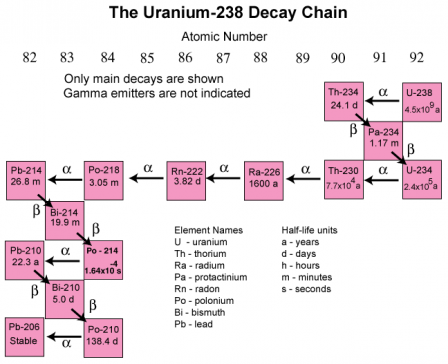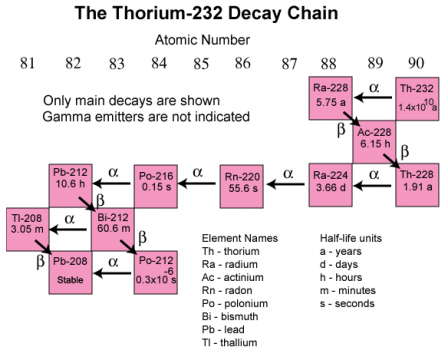Radioactive Decay
Radioactive decay is the emission of energy in the form of ionizing radiation![]() ionizing radiationRadiation with so much energy it can knock electrons out of atoms. Ionizing radiation can affect the atoms in living things, so it poses a health risk by damaging tissue and DNA in genes.. The ionizing radiation that is emitted can include alpha particles
ionizing radiationRadiation with so much energy it can knock electrons out of atoms. Ionizing radiation can affect the atoms in living things, so it poses a health risk by damaging tissue and DNA in genes.. The ionizing radiation that is emitted can include alpha particles![]() alpha particleA form of particulate ionizing radiation made up of two neutrons and two protons. Alpha particles pose no direct or external radiation threat; however, they can pose a serious health threat if ingested or inhaled., beta particles
alpha particleA form of particulate ionizing radiation made up of two neutrons and two protons. Alpha particles pose no direct or external radiation threat; however, they can pose a serious health threat if ingested or inhaled., beta particles![]() beta particleA form of particulate ionizing radiation made up of small, fast-moving particles. Some beta particles are capable of penetrating the skin and causing damage such as skin burns. Beta-emitters are most hazardous when they are inhaled or swallowed. and/or gamma rays
beta particleA form of particulate ionizing radiation made up of small, fast-moving particles. Some beta particles are capable of penetrating the skin and causing damage such as skin burns. Beta-emitters are most hazardous when they are inhaled or swallowed. and/or gamma rays![]() gamma raysA form of ionizing radiation that is made up of weightless packets of energy called photons. Gamma rays can pass completely through the human body; as they pass through, they can cause damage to tissue and DNA.. Radioactive decay occurs in unbalanced atoms called radionuclides.
gamma raysA form of ionizing radiation that is made up of weightless packets of energy called photons. Gamma rays can pass completely through the human body; as they pass through, they can cause damage to tissue and DNA.. Radioactive decay occurs in unbalanced atoms called radionuclides.
When it decays, a radionuclide transforms into a different atom - a decay product. The atoms keep transforming to new decay products until they reach a stable state and are no longer radioactive. The majority of radionuclides only decay once before becoming stable. Those that decay in more than one step are called series radionuclides. The series of decay products created to reach this balance is called the decay chain![]() decay chainThe series of decays or transformations that radionuclides go through before reaching a stable form. For example, the decay chain that begins with Uranium-238 culminates in Lead-206, after forming intermediates such as Uranium-234, Thorium-230, Radium-226, and Radon-222. Also called the "decay series.".
decay chainThe series of decays or transformations that radionuclides go through before reaching a stable form. For example, the decay chain that begins with Uranium-238 culminates in Lead-206, after forming intermediates such as Uranium-234, Thorium-230, Radium-226, and Radon-222. Also called the "decay series.".
Each series has its own unique decay chain. The decay products within the chain are always radioactive. Only the final, stable atom in the chain is not radioactive. Some decay products are a different chemical element.
Every radionuclide has a specific decay rate, which is measured in terms of "half-life![]() half-lifeThe time required for half of the radioactive atoms present to decay or transform. Some radionuclides have half-lives of mere seconds, but others have half-lives of hundreds or millions of years.." Radioactive half-life is the time required for half of the radioactive atoms present to decay. Some radionuclides have half-lives of mere seconds, but others have half-lives of hundreds or millions or billions of years.
half-lifeThe time required for half of the radioactive atoms present to decay or transform. Some radionuclides have half-lives of mere seconds, but others have half-lives of hundreds or millions of years.." Radioactive half-life is the time required for half of the radioactive atoms present to decay. Some radionuclides have half-lives of mere seconds, but others have half-lives of hundreds or millions or billions of years.
Two decay chains are shown below:
- Uranium-238.
- Thorium-232.
 Source: U.S. Geological Survey (USGS)
Source: U.S. Geological Survey (USGS)
 Source: U.S. Geological Survey (USGS)
Source: U.S. Geological Survey (USGS)
